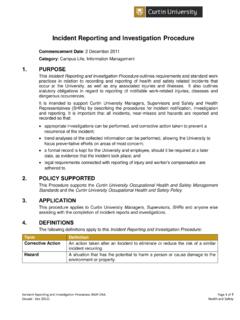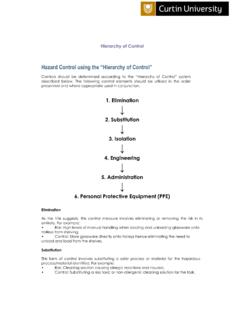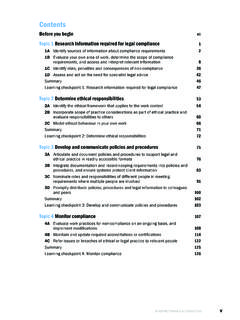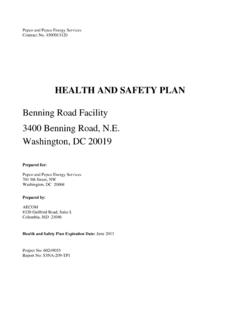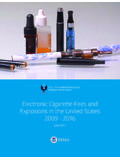Transcription of Incident Reporting and Investigation Guidelines
1 Incident Investigation Page 1 of 14 (Issued: Dec 2011) health and safety Incident Investigation Guidelines Commencement Date: 02 December 2011 Category: Campus Life, Information Management 1. PURPOSE This Incident Investigation Guideline is a guide to completing an Incident Investigation and the Incident Reporting and Investigation form. It is designed to meet the legislative requirements for Incident Reporting and Investigation outlined in the OSH Act [1] and OHS Regulations [2]. 2. PROCEDURE SUPPORTED This Incident Investigation Guideline supports the Curtin University Incident Reporting and Investigation procedure. 3. APPLICATION This guideline applies to Curtin University Managers, Supervisors, SHRs and anyone else assisting with the completion of Incident reports and investigations.
2 4. DEFINITIONS The following definitions apply to this Incident Reporting and Investigation Procedure: Term Definition Hazard A situation that has the potential to harm a person or cause damage to the environment or property. Hierarchy of Controls A complete definition of Hierarchy of Controls is contained in the Writing Safe Work Procedures Guideline. Illness Any work related illness, including disease. Incident Any unplanned event resulting in, or having a potential for injury, ill health , damage or other loss. (AS/NZS 4801:2001 [3]) Serious injury or illness An injury or illness that will result in the affected person losing one or more working days or shifts. Actual Consequence Actual Consequence is defined as insignificant, minor, moderate, major and catastrophic based on the University health and safety Risk Matrix.
3 It describes the consequence of the Incident . Potential Risk Potential risk is defined as low, medium, high or extreme based on the University health and safety Risk Matrix prior to any corrective actions or controls have been implemented. Residual Risk Residual risk is defined as low, medium, high or extreme based on the University health and safety Risk Matrix after recommended corrective actions or controls have been implemented. Incident Investigation Page 2 of 14 (Issued: Dec 2011) health and safety 5. EXCEPTIONS Incidents of bullying and stress are to be reported using the online Incident /hazard Reporting system. These incidents are not required to be seen by a Manager or SHRs and will be managed in accordance with the University s policy on Bullying in the Workplace. 6. CONDUCTING THE Incident Investigation Initial Investigation Investigation procedures need to be systematic.
4 The Investigation team should: act as soon as possible after the Incident ; visit the scene before physical evidence is disturbed; not prejudge the situation; not remove anything from the scene; enquire if anyone else has moved anything; and take photographs and/or sketches to assist in reconstructing the Incident . After the initial Investigation After the initial Investigation is complete the team should: identify, label and store all evidence. For example, tools, defective equipment, fragments, chemical samples etc; interview each witness separately; ascertain if there have been any near hits in similar circumstances; record all sources of information; keep records to show that the Investigation was conducted in a fair and impartial manner; review all potentially useful information, including design specifications, operating logs, purchasing records, previous reports, procedures, equipment manuals, job safety analysis reports, records of training and instruction of the people involved and experiences of people in similar workplaces/industries; and reconstruct the Incident (while ensuring that another Incident doesn t occur) to assist in verifying facts, identify what went wrong and what can be done to prevent it happening again.
5 What to look for Look for causes, not blame. Systems fail for many reasons and the people involved are not always the cause of the Incident . Build a chain of events to identify all the causes. For the Investigation to be successful it is necessary to establish the following information: Incident Investigation Page 3 of 14 (Issued: Dec 2011) health and safety Events leading up to the Incident Investigate: the system of work being carried out and the adequacy or suitability of that system for the job; the instructions and/or training given for the work; any variation from instructions or standard work practices and the reasons for such variation; the workplace conditions, such as lighting, floor surfaces, stair treads and handrails, warning signs, temperature and weather (if the Incident occurred outside); the exact location of the Incident with sufficient detail for the spot to be readily identified by others reading the report ; the materials in use or being handled; the type of transport or equipment in use.
6 And whether adequate supervision was provided. Facts of the Incident itself Investigate: the state of the system and the actions that occurred at the time; the people directly and indirectly involved; the tools, equipment, materials and fixtures directly connected; and the time the accident or Incident occurred. Facts regarding what occurred immediately after the Incident Investigate: any injuries or damage resulting directly from the Incident ; what people are involved, including those rendering aid; and any problems in dealing with the injuries or damage, for example faulty extinguisher, isolation switch difficult to locate. Essential factors and causes To conduct an effective accident/ Incident Investigation , it is essential to look at all aspects of design, environment/work process, and behaviour components, such as plant, procedures and people, rather than trying to isolate a single cause.
7 Design components Poor systems design may result in exposure to hazards such as: unguarded dangerous parts of machinery; ineffective safety devices; provision of makeshift plant, equipment and tools; and inadequate ventilation. Incident Investigation Page 4 of 14 (Issued: Dec 2011) health and safety Environmental components/work processes How people function in the work environment depends on what they experience in it. Environmental factors may be both physical and social. The way in which people do the job, the procedures and work processes followed are important factors in Incident Investigation . Poor work process may lead to hazard exposure. Behavioural components Examples include misuse of safeguards, improper use of tools and equipment, disregard of cautionary notices, failure to wear personal protective equipment, horseplay and poor standards of housekeeping.
8 Poor practices may indicate that improved communication, further training or some other action, such as supervision, are necessary. The common practice in industrial accident/ Incident Investigation is to look for the cause of any accident/ Incident . Searching for a single cause of an accident/ Incident is restrictive. It focuses attention on only one, or at best a very few, of the essential factors while others, which may be more easily controlled, pass unnoticed. 7. DOCUMENTING THE Investigation Login to RMSS and Print Investigation Form As an investigator you will be assigned a temporary login and password. Login to RMSS at and use your temporary login and password to login. Complete the Investigation Form Incident Investigations can be completed using the Incident Reporting and Investigation form available from the Event and Hazard page under health and safety on the Curtin University website at: Managers and Supervisors shall monitor and record progress of implementing of corrective actions and notify the safety Advisor once implementation of corrective actions is finalised.
9 The following describes the sections of the template Incident Investigation form: 1. [Click to add Short Title] Incident : Add a short title that best describes the Incident . Incident Details Incident Investigation Page 5 of 14 (Issued: Dec 2011) health and safety 2. Incident report No: Add the RMSS reference number if known. 3. Incident Reported by: Name of the person who first reported the Incident . 4. Persons Injured/involved: Name of the person injured or involved. 5. Date of Incident : Date the Incident occurred. 6. Date of report : Date the report is finalised. Investigation Details 7. Name of person completing this form: Insert the name of the author of the report . 8. Telephone Number: The number of the author of the report . 9. Email Address: The email addresss of the author of the report . 10. Investigation Team members: List the names and contact telephone numbers of the Investigation team.
10 11. Name(s) of persons interviewed as part of this Investigation : List all witnesses interviewed. Incident Investigation Page 6 of 14 (Issued: Dec 2011) health and safety Description of Events 12. Describe the task being performed at the time of the Incident : Free text. 13. Describe the sequence of events leading to the Incident : Free text. 14. Describe equipment tools involved: List any equipment or tools involved in the Incident . 15. Describe materials being handled: List any materials being handled. 16. Describe any unusual condition(s): For example, wet weather. 17. Conclusion: Describe your conclusions about the Incident . Incident Investigation Page 7 of 14 (Issued: Dec 2011) health and safety Root Cause Analysis Incident Investigation Page 8 of 14 (Issued: Dec 2011) health and safety 18.
